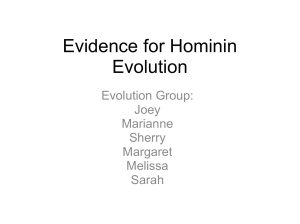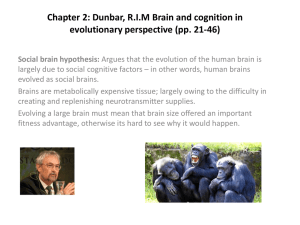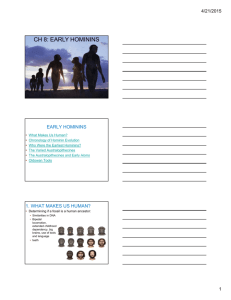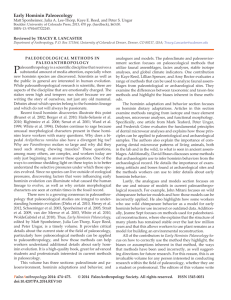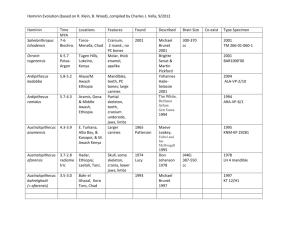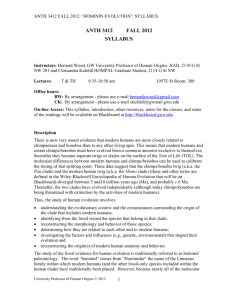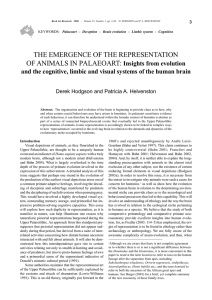Homo erectus - No Brain Too Small
advertisement
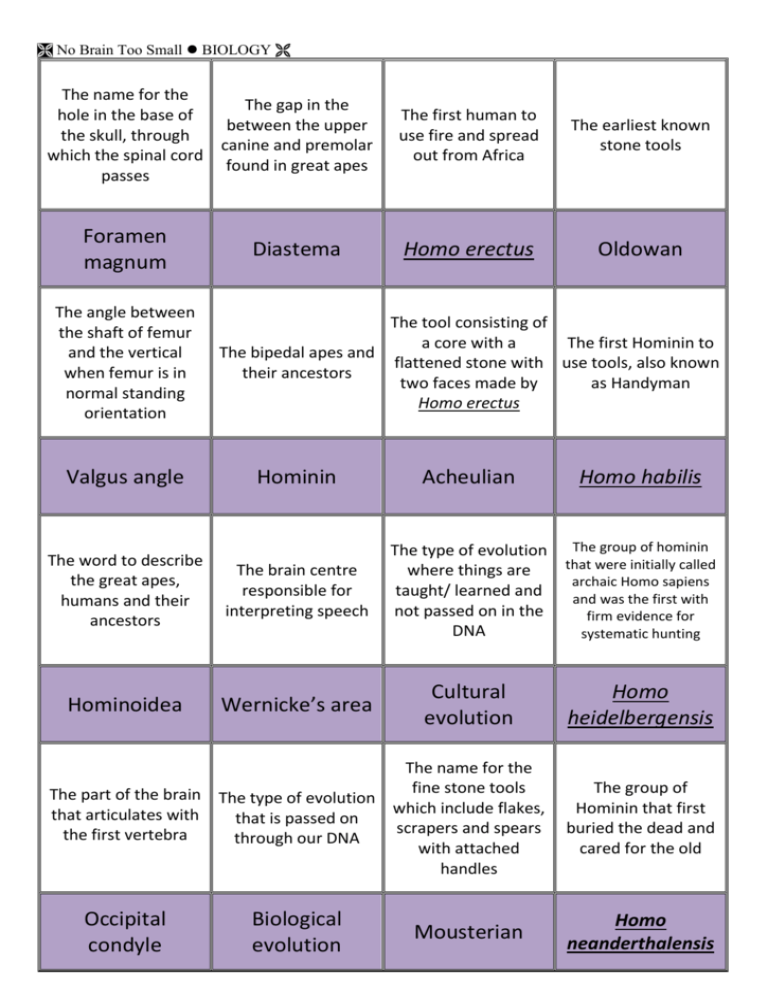
No Brain Too Small BIOLOGY The name for the The gap in the hole in the base of between the upper the skull, through canine and premolar which the spinal cord found in great apes passes Foramen magnum The angle between the shaft of femur and the vertical when femur is in normal standing orientation Valgus angle Diastema The first human to use fire and spread out from Africa The earliest known stone tools Homo erectus Oldowan The tool consisting of a core with a The first Hominin to The bipedal apes and flattened stone with use tools, also known their ancestors two faces made by as Handyman Homo erectus Hominin The word to describe the great apes, humans and their ancestors The brain centre responsible for interpreting speech Hominoidea Wernicke’s area Acheulian The type of evolution The group of hominin that were initially called where things are archaic Homo sapiens taught/ learned and and was the first with not passed on in the firm evidence for DNA systematic hunting Cultural evolution The name for the fine stone tools The part of the brain The type of evolution which include flakes, that articulates with that is passed on scrapers and spears the first vertebra through our DNA with attached handles Occipital condyle Biological evolution Homo habilis Mousterian Homo heidelbergensis The group of Hominin that first buried the dead and cared for the old Homo neanderthalensis No Brain Too Small BIOLOGY The area of the brain that is most enlarged The first animal to be in apes, most of all in domesticated humans Cerebrum Dog The name for the The scientific name culture that included for “Lucy” the first to the Oldowan and probable walk Acheulian together. upright Also called ‘Old Stone Age’ The shape of the pelvis in bipedal organisms The crest along the top of the skull Bowl shaped Sagittal The name for the Neanderthal tool culture The later phase of the Old Stone Age Mousterian Upper Palaeolithic Australopithecus afarensis Lower Palaeolithic A tool made of more than one kind of material The view that modern humans evolved independently in Africa, Europe and Asia The first species to make and use needles The theory that modern humans evolved in Africa and then migrated to Europe and Asia, displacing other earlier species Composite Multiregional Homo sapiens ‘Out of Africa’ Heavy bone over the eye which reduces the stresses in the skull and lower jaw involved with chewing This means ‘having a snout/muzzle’ Gap through which large jaw muscles pass Another name for the Out of Africa hypothesis Zygomatic arch Replacement hypothesis or Eve hypothesis Brow Ridge Prognathism No Brain Too Small BIOLOGY What do ice ages do to the seas water levels? What is mtDNA? Lowers water level Mitochondrial DNA, creating land bridges which is only passed between islands on to daughters Why can Y chromosomes be used to show patterns of evolution? How can mtDNA and Y chromosome DNA be altered? Because it is passed on only to sons and isn’t affected by recombination Through mutations How did Australopithecus obtain food? What does cooking food do to it? What where the advantages of fire? How did tools help Hominin survive? Scavenging what they found Softens it, kill microbes Cooks food, hardens tools, lengthens day, kept warm, keeps predators away Allowed more diverse animals to be killed and processed Over time how did the brain size of the Hominin change? Over time how did the prognathic muzzle change? Sexual dimorphism Brain size increased It reduced Over time how did the brow ridge change? How did the feet change when we became bipedal? Why is the Out of Africa hypothesis also called replacement hypothesis? What is the difference in the shape of the spine in modern apes and human? It became reduced Forward facing big toe, arched, big toe attached When they moved out of Africa, they out competed any Hominin they came into contact with, making them extinct c-shaped apes s-shaped humans How did the position What is the name for of the foramen the differences magnum change observed between when Hominin male and female became bipedal? skeletons? Moved from the lower back of skull towards the centre No Brain Too Small BIOLOGY What are the advantages of being bipedal? How has cultural evolution changed over time? Taller so can see predators / food, hands free to carry food/ young / tools, more efficient cooling Tools better, use of shelter, abstract thought, imagination, domestication of animals / plants What do Lower Palaeolithic – Oldowan tools look like? What do Lower Palaeolithic – Acheulian tools look like? Pebbles with Tear drop flakes knocked off shaped pebbles one edge What are the Middle Palaeolithic tools? What are the Upper Palaeolithic tools? How did the tools change over time? What does the evidence of Cave drawings, burial of dead, planned hunting groups indicate? Mousterian and scrapers axe heads Needles, fish hocks made from bone and wood They became more refined and more worked The ability for abstract thought Living in trees is called…. What shape/ dental arcade is the jaw in apes? What shape/ dental arcade is the jaw in humans? All primates can grip objects with a ______ grip. Only humans also have a ______ grip. Arboreal “U” or rectangle Parabola Power grip Precision grip What are the advantages of a shorter pelvis? What is the name of the process where one change reinforces another? It is stronger & able to tilt and rotate during walking Positive feedback Using the Using the Replacement Multiregional Hypothesis when do Hypothesis when did they think our our ancestors leave ancestors left Africa? Africa? About 200,000 years ago About 1 million years ago No Brain Too Small BIOLOGY

